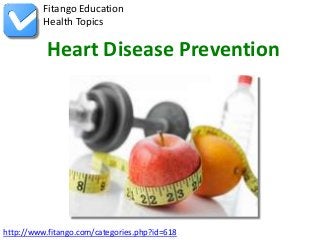
Heart Disease Prevention
- 1. http://www.fitango.com/categories.php?id=618 Fitango Education Health Topics Heart Disease Prevention
- 2. 1 What you can do **Live a Healthy Lifestyle** -- Eat a healthy diet. Choosing healthful meal and snack options can help you avoid heart disease and its complications. Be sure to eat plenty of fresh fruits and vegetables.
- 3. 2 What you can do **Live a Healthy Lifestyle** -- Eating foods low in saturated fat and cholesterol and high in fiber can help prevent high blood cholesterol. Limiting salt or sodium in your diet can also lower your blood pressure.
- 4. 3 What you can do **Live a Healthy Lifestyle** -- Maintain a healthy weight. Being overweight or obese can increase your risk for heart disease. To determine whether your weight is in a healthy range, doctors often calculate a number called the body mass index (BMI). Doctors sometimes also use waist and hip measurements to measure a person's excess body fat.
- 5. 4 What you can do **Live a Healthy Lifestyle** -- Exercise regularly. Physical activity can help you maintain a healthy weight and lower cholesterol and blood pressure. The Surgeon General recommends that adults should engage in moderate-intensity exercise for at least 30 minutes on most days of the week.
- 6. 5 What you can do **Live a Healthy Lifestyle** -- Don't smoke. Cigarette smoking greatly increases your risk for heart disease. So, if you don't smoke, don't start. If you do smoke, quitting will lower your risk for heart disease. Your doctor can suggest ways to help you quit. -- Limit alcohol use. Avoid drinking too much alcohol, which causes high blood pressure.
- 7. 6 Lowering Your Risk If you have high cholesterol, high blood pressure, or diabetes, there are steps you can take to lower your risk for heart disease. Have your cholesterol checked. Your health care provider should test your cholesterol levels at least once every five years. Talk with your doctor about this simple blood test.
- 8. 7 Lowering Your Risk Monitor your blood pressure. High blood pressure has no symptoms, so be sure to have it checked on a regular basis. Manage your diabetes.If you have diabetes, closely monitor your blood sugar levels. Talk with your health care provider about treatment options.
- 9. 8 Lowering Your Risk Take your medicine. If you're taking medication to treat high cholesterol, high blood pressure, or diabetes, follow your doctor's instructions carefully. Always ask questions if you don't understand something.
- 10. 9 Lowering Your Risk Talk with your health care provider. You and your doctor can work together to prevent or treat the medical conditions that lead to heart disease. Discuss your treatment plan regularly and bring a list of questions to your appointments.
- 11. 10 Aspirin Use **Recommendations for Aspirin Use to Control Existing Cardiovascular Disease**Aspirin can be beneficial to individuals who already have experienced a heart attack, stroke, angina or peripheral vascular disease, or have had certain procedures such as angioplasty or bypass. Doctors may recommend aspirin use for persons with these conditions unless there is another medical reason why these individuals should not take aspirin. Because aspirin may not be the most effective therapy for everyone, other anti-platelet medicines may be used instead of aspirin or along with aspirin.
- 12. 11 Aspirin Use **Recommendations for Aspirin Use to Prevent Cardiovascular Disease**Aspirin can be taken to prevent heart disease and stroke in some individuals who have not previously experienced these events. The U.S. Preventive Services Task Force (USPSTF) recommends that men with no history of heart disease or stroke aged 45-79 years use aspirin to prevent myocardial infarctions and that women with no history of heart disease or stroke aged 55-79 use aspirin to prevent stroke when the benefit of aspirin use outweighs the potential harm of gastrointestinal hemorrhage or othe
- 13. 12 Risk Factors Some conditions as well as some lifestyle factors can put people at a higher risk for developing heart disease. All persons can take steps to lower their risk of heart disease and heart attack by addressing these risk factors. Control of risk factors is especially need by people who already have heart disease. Conditions